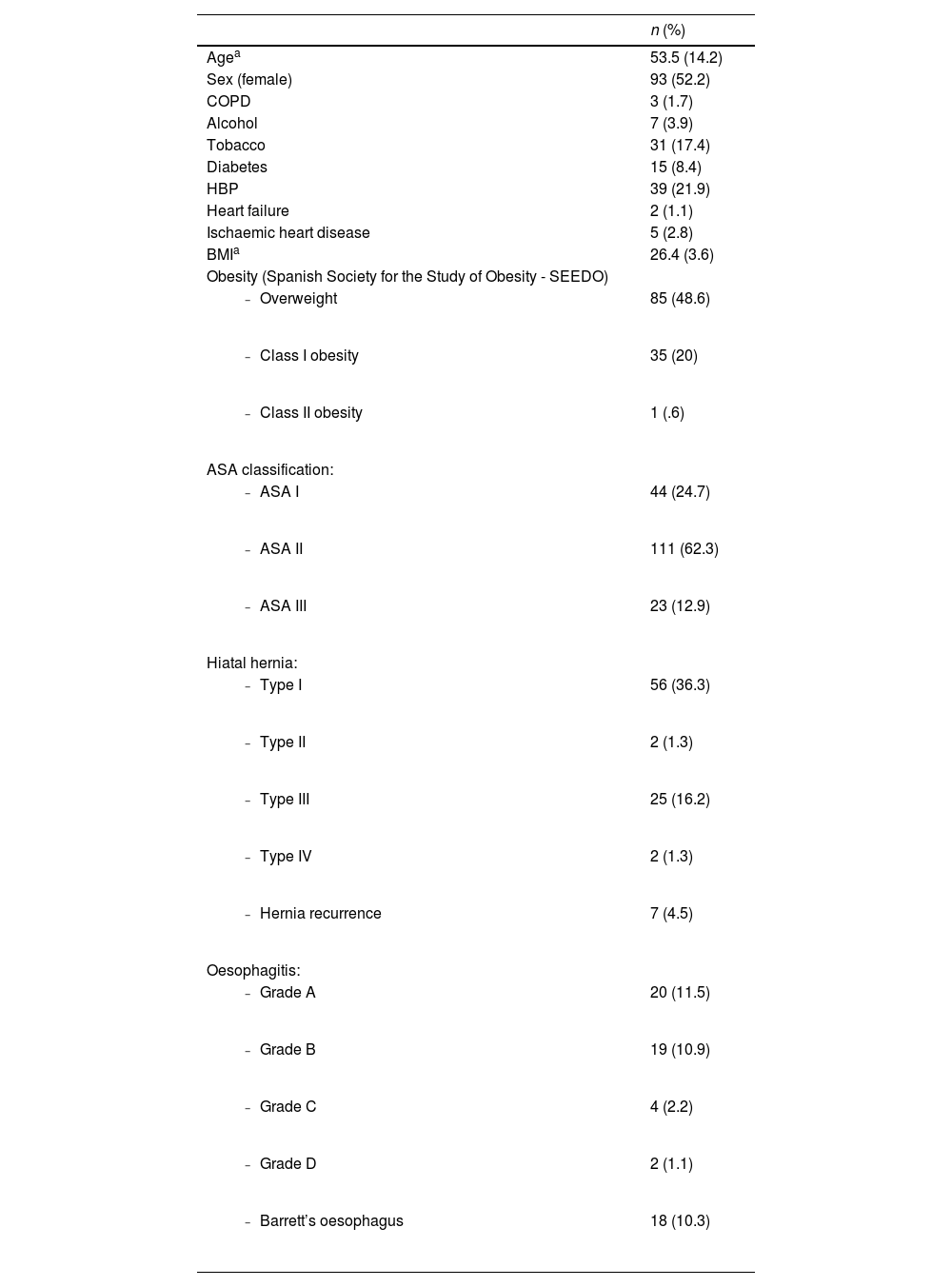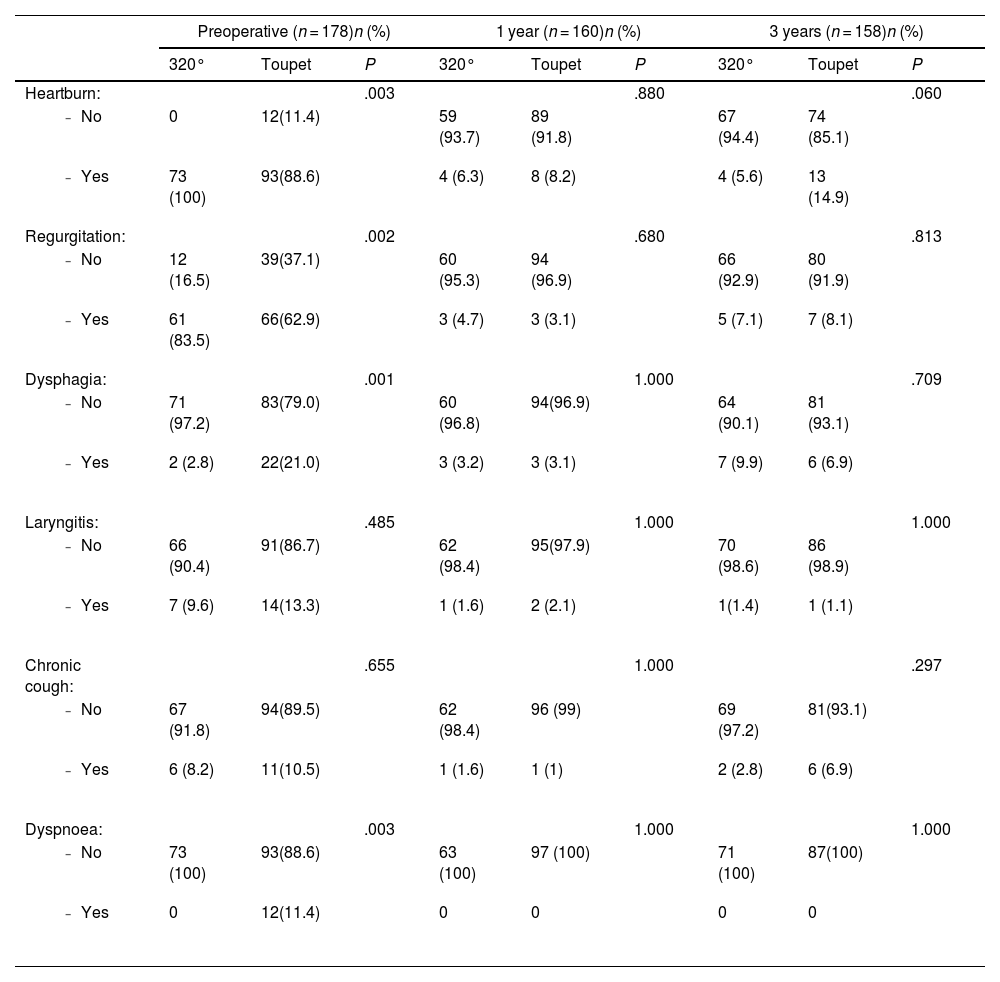Antireflux surgery is commonly associated with significant recurrence and complication rates, and several surgical techniques have been proposed to minimize them. The aim of this study is to evaluate the results of a fundoplication with extensive dissection of the esophagogastric junction 1 and 3 years after the procedure.
MethodsRetrospective observational study including 178 patients with gastroesophageal reflux disease or hiatal hernia who underwent fundoplication with extensive dissection of the esophagogastric junction between 2015 and 2020. Hernia recurrence, symptoms and quality of life at 1 and 3 years after surgery were assessed by barium transit, endoscopy and questionnaires for symptoms and quality of life (GERD-HRQL).
ResultsHeartburn rate was 7.5% and 10.7% at 1 and 3 years respectively, regurgitation 3.8% and 6.9% and dysphagia was 3.7% and 7.6%. The presence of hiatal hernia was evident preoperatively in 55.1% and in 7.8% and 9.6% at follow-up and the median GERD-HRQL scale was 27, 2 and 0 respectively. There were no cases of slippage of the fundoplication or symptoms suggestive of vagal injury. No differences were found when comparing the different types of fundoplication in terms of reflux and recurrence or complications.
ConclusionsFundoplication with extensive dissection of the esophagogastric junction contributes to correct positioning and better anchorage of the fundoplication, which is associated with low rates of hiatal hernia and reflux recurrence, as well as absence of slippage and lower possibility of vagal injury.
La cirugía antirreflujo, se asocia con frecuencia a tasas significativas de recurrencia y complicaciones habiéndose propuesto varias técnicas quirúrgicas para minimizarlas. El objetivo del estudio es evaluar los resultados a 3 años de una funduplicatura con disección extensa de la unión esofagogástrica.
MétodosEstudio observacional retrospectivo que incluyó a 178 pacientes con enfermedad por reflujo gastroesofágico o hernia de hiato a los que se les realizó una funduplicatura con disección extensa de la unión esofagogástrica entre 2015 y 2020. La recidiva herniaria, los síntomas y la calidad de vida al año y 3 años de la cirugía fueron evaluados mediante tránsito baritado, endoscopia y cuestionarios para síntomas y calidad de vida (GERD-HRQL).
ResultadosLa tasa de pirosis fue de 7,5% y 10,7% al año y 3 años respectivamente, regurgitación 3,8% y 6,9% y disfagia fue 3,7% y 7,6%. La presencia de hernia hiatal se evidenció preoperatoriamente en el 55,1% y en el 7,8% y 9,6% en el seguimiento y la mediana de la escala GERD-HRQL fue 27, 2 y 0 repectivamente. No aparecieron casos de telescopaje de la funduplicatura ni síntomas que sugieran lesión vagal. No se encontraron diferencias al comparar los distintos tipos de funduplicatura en términos de recidiva del reflujo, complicaciones o recurrencia de la hernia.
ConclusionesLa funduplicatura con disección extensa de la unión esofagogástrica contribuye a su correcto posicionamiento y mejor anclaje, lo que asocia bajas tasas de recidiva herniaria y del reflujo, así como disminuye la posibilidad de telescopaje y lesión vagal.














